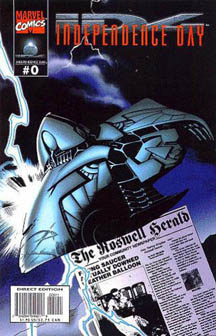To celebrate the 20th anniversary of “Independence Day” and the release of the sequel, “Resurgence,” this week I’m looking back at the various spinoff comics and novels. All of these spin-off materials were recently released (or re-released, in the case of the old stuff) by Titan Books. Also, check out my reviews of “Independence Day” and “Independence Day: Resurgence.”
Let’s start at the beginning, or rather, before the beginning: the prequel. In conjunction with the 1996 movie, Marvel put out a two-issue comic adaptation and preceded it with Issue No. 0, written by Phil Crain.
Issue 0 is obviously a commercial project, in the sense that idea of having a prequel comic likely preceded the idea for what would be in the comic. Crain gives us the Roswell crash story and briefly sketched-out backstories for the film’s major players, but none of it is essential.
“ID4’s” Roswell UFO incident of 1947 hews closely to real-world lore. The alleged crash – “due to a navigational mishap” – occurs on July 4, 1947, in the “ID4” timeline, whereas some reports say in happened on June 14 (although the Brazel family, who spotted the debris, gathered it up on July 4 in many reports). Of course, it’s understandable that the “ID4” lore would embrace the July 4 date. Crain takes us through the real-life plot points quickly, from the “light and strong” metal debris to the military’s “weather balloon” cover story. Then it smoothly skews into the “ID4” narrative about the transfer of the ship and the aliens to a newly built secret facility (Area 51 in Nevada).
Disturbingly, a soldier sternly tells Mr. Brazel: “Someone from the U.S. Army would like to speak with you,” and Brazel is never seen again. This isn’t quite as sinister as it sounds, as in the real-world narrative, Brazel was not killed, he was coerced into changing his story. But in the comic, it plays ominously.
Back to the “ID4” narrative: An Army scientist named Dr. Rose volunteers to study the craft and the three aliens. One of them is injured but still alive, and it melds with Rose’s brain just before it dies. Then for 20 years, we see our tax dollars at work: Rose learns almost nothing from the corpses and the ship before handing off the project to Dr. Okun in 1967, who proceeds to learn next to nothing over the next two decades.
Then it’s on to the character chapters, which canonize points that were implied but not made explicit in the movie. We see Russell Casse’s 1986 abduction and his subsequent spiral into alcoholism when everyone laughs at his story. We see Steven Hiller’s younger brothers tell him there’s “no such thing” as a black astronaut, although his mom is supportive of his dreams.
We see that Okun somewhat fears the three alien corpses, as he dreams about one of them coming to life and attacking him in the darkened lab. On my first viewing of the film, I kind of suspected one of the corpses would spring to life and burst out of its glass prison, so this scene tracks nicely.

We see David Levinson punch Thomas Whitmore – as referenced in the film — because of his completely unfounded belief that his wife, Connie, is having an affair with the senator. Usually when someone punches a politician, I side with the puncher, but in this case Levinson is unquestionably the jackass of the piece. It’s a reminder that Levinson isn’t the greatest character on paper; it’s Jeff Goldblum’s charisma that makes him likable.
As “ID4” opens, Whitmore has low favorability ratings from the public for vague reasons, and Crain keeps the reasons vague. A TV commentator criticizes the president for being “too pragmatic” (!). The movie also shows us that Nimziki, the secretary of defense, is the one member of the Joint Chiefs of Staff who is a bit sleazy, but the backstory of why Whitmore selected him is bland: Whitmore just chooses Nimziki because he has lots of experience as the head of the CIA, despite Connie’s objections. I guess it’s a pragmatic decision.
In short, this prequel comic is fine – a team of four artists deliver good likenesses of the actors — but it doesn’t add any depth to the lore. I suspect the prequel novel, “Silent Zone,” will do a better job in this regard.
One advantage to picking up Titan’s trade paperback of Issues 0-2 is you get a nice “ID4” map/timeline in the back featuring events from 1947 through 2016. But it’s also found in the “Dark Fathom” TPB, and you’ll get a better story there.

